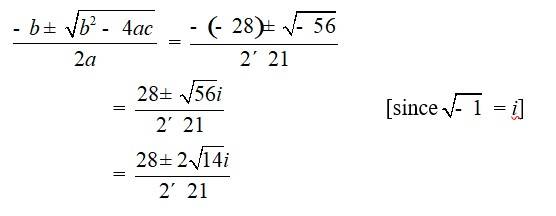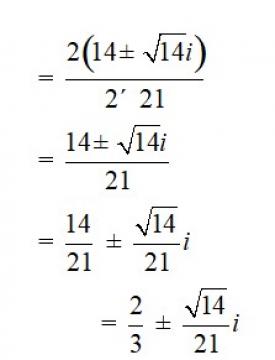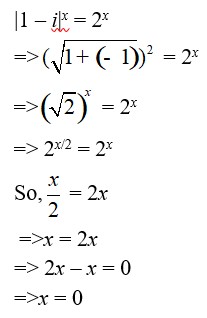Maths
Get insights from 6.5k questions on Maths, answered by students, alumni, and experts. You may also ask and answer any question you like about Maths
Follow Ask QuestionQuestions
Discussions
Active Users
Followers
New answer posted
6 months agoContributor-Level 10
40.
So, the only solution of the given equation is 0.
Hence, there is no non – zero integral solution of the given equation.
New question posted
6 months agoNew answer posted
6 months agoContributor-Level 10
39. (x + iy)3 = u + iv
=>x3 + (iy)3 + 3.x.iy (x + iy) = u + iv [since, (a + b)3 = a3 + b3 + 3ab (a + b)]
=>x3 – iy3 + 3x2yi + 3xy2i2 = u + iv
=>x3 – iy3 + 3x2yi – 3xy2 = u + iv [since, i2 = -1]
=> (x3 – 3xy2) + i (3x2y – y3) = u + iv
Equating real and imaginary part we get,
u = x3 – 3xy2 and v = 3x2y – y3
Now, +
= +
= +
= x2 – 3y2 + 3x2 – y2
= 4x2 – 4y2
= 4 (x2 – y2)
Hence proved.
New answer posted
6 months agoContributor-Level 10
38. –
=
= [Since, (a + b)2 = a2 + b2 + 2ab
(a – b)2 = a2 + b2 – 2ab
a2 – b2 = (a + b) (a – b)]
= [Since, i2 = –1]
=
= 2i

New answer posted
6 months agoContributor-Level 10
37. Let z = (x – iy) (3 + 5i)
= 3x + 5xi – 3yi – 5yi2
= (3x + 5y) + (5x – 3y)i
Given, = –6 – 24i
=> (3x + 5y) – (5x – 3y)i = –6 – 24i
Equating real and imaginary part,
3x + 5y = –6 - (1)
5x – 3y = 24 - (2)
Multiplying (1) by 3 and (2) by 5 and adding them, we get
9x + 15y + 25x – 15y = –18 + 120
=> 34x = 102
=>x = 102/34 = 3
Putting x = 3 in (1) we get,
3 * 3 + 5y = –6
=> 9 + 5y = –6
=> 5y = –6 – 9
=> 5y = –15
=>y = –15/5 = –3
Hence, the values of x and y are 3 and –3 respectively.
New answer posted
6 months agoContributor-Level 10
36. Z1 = 2 – i, z2 = –2 + i
Z1z2 = (2 – i)(–2 + i)
= –4 + 2i + 2i – i2
= –4 + 4i + 1[since, i2 = –1]
= –3 + 4i
= 2 + i
i. =
= * [multiply denominator and numerator by (2 – i)]
=
= [since, i2 = –1]
=
=
= +
So, Re( ) =
ii. =
=
= [since, i2 = –1]
= + 0i
Therefore, Im = 0
New answer posted
6 months agoContributor-Level 10
35. Let, z = a + ib
=
= [since, (a + b)2 = a2 + b2 + 2ab]
= [since, i2 = –1]
= +
So, |z|2 = a2 + b2
= +
= [since, (a + b)2 = a2 + b2 + 2ab]
=
=
= [as, (a + b)2 = a2 + b2 + 2ab]
Hence proved.
New answer posted
6 months agoContributor-Level 10
34. z1 = 2 – i ,z2 = 1 + i
=
=
=
=
= * [multiply numerator and denominator by (1 + i)]
=
= [since, i2 = –1]
=
=
= |1 + i|

New answer posted
6 months agoContributor-Level 10
33. 21x2 – 28x + 10 = 0
Comparing the given equation with ax2 + bx + c = 0
We have, a = 21, b = –28 andc = 10
Hence, discriminant of the equation is
b2 – 4ac = ( 28)2 – 4 * 21 * 10 = 784 – 840 = –56
Therefore, the solution of the quadratic equation is


New answer posted
6 months agoContributor-Level 10
32. 27x2 – 10x + 1 = 0
Comparing the given equation with ax2 + bx + c = 0
We have, a = 27, b = –10 andc = 1
Hence, discriminant of the equation is
b2 – 4ac = ( 10)2 – 4 * 27 * 1 = 100 – 108 = –8
Therefore, the solution of the quadratic equation is

Taking an Exam? Selecting a College?
Get authentic answers from experts, students and alumni that you won't find anywhere else
Sign Up on ShikshaOn Shiksha, get access to
- 65k Colleges
- 1.2k Exams
- 679k Reviews
- 1800k Answers

